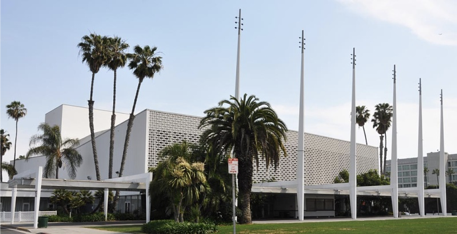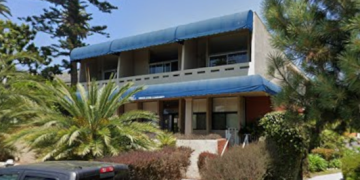
The Santa Monica Civic Auditorium stands as more than a shuttered venue awaiting revival—it remains an active force in global performance architecture and cultural memory, its influence reverberating through concert halls from London to Tokyo even as its doors have been closed since 2012. This Auditorium isn’t merely a building; it’s a testament to mid-century civic ambition and is celebrated for its sophistication, embodying the Vitruvian ideal by combining structural integrity (firmitas), functional excellence (utilitas), and aesthetic delight (venustas).
The architectural icon, designed by 26-year-old architect Louis Naidorf with Welton Becket & Associates in 1958, transcends its physical boundaries. The sweeping, curved abstract brise soleil form rising over a glass curtain wall façade embodies a revolutionary approach to democratic cultural space that the world still emulates today. The building’s ability to transform from intimate venue to grand civic space demonstrates a sophistication in design that no amount of new construction can replicate.
The Blueprint That Changed Performance Venues Worldwide
The Civic Auditorium’s pioneering acoustic design, developed with UCLA’s acoustical physicist and Chancellor, Vern O. Knudsen, created a template that fundamentally altered how performance spaces were conceived globally. It introduced a rare degree of acoustic adaptability for a building of its size. Coupling Naidorf’s innovative “floating stage floor” (enabling both flat and sloped venues), retractable seating for 3,000 viewers, suspended ceiling panels over a column-free interior, Knudsen designed seamless sonic transitions between symphonic performances, spoken-word events, and amplified concerts.
This architectural DNA can be traced directly to renown venues that followed: the Dorothy Chandler Pavilion, the Kennedy Center Concert Hall, London’s Barbican Centre, and the refurbishment of Sydney Opera House Concert Hall, all bear the Civic’s fingerprints, proving that a single space could serve multiple cultural functions without compromise. Seemingly an impossible concept before Naidorf’s Auditorium showed the world how to achieve it.
Knudsen implemented integrated spatial design to minimize acoustical vibration transfer to become the industry standards. Tokyo’s Budokan and Amsterdam’s Paradiso specifically emulated the Civic’s approach to a natural sound balance, while Berlin’s Philharmonie concert hall adopted its philosophy of treating hearing a performance via architectural materials inseparable from form. Even today, architects studying multipurpose venue design reference the Santa Monica Civic as the original model for acoustic flexibility.
The Concert That Invented Modern Music Media
On October 28-29, 1964, The T.A.M.I. Show hosted an event that fundamentally transformed how the world experiences live music. Featuring legendary performances by James Brown alongside The Rolling Stones, The Beach Boys, The Supremes, and Marvin Gaye, pioneered multi-camera concert filming, live color editing, and a cutting-edge ‘electrono-vision’ technology.
This production, sixty-one years ago at the Civic, created the visual language still used today in every major concert broadcast, from Live Aid to MTV Unplugged to contemporary streaming concerts. The techniques developed became the global standard, influencing not just how concerts are filmed but how venues themselves are designed to accommodate both live audiences and broadcast requirements. Every time a concert is streamed worldwide today, it follows the blueprint created at Santa Monica’s Civic Auditorium.
A Continuing Cultural Force Despite Closure
The Civic’s influence has paradoxically grown during its dormancy for 13 years. Contemporary venue designers study its adaptability as they grapple with post-pandemic demands for flexible cultural spaces. Electronic music venues like London’s Printworks and Berlin’s Kraftwerk explicitly reference the Civic’s ability to transform intimate experiences into immersive spectacles, inspired by performances that demonstrated how festival-scale production could work in compact indoor spaces.
The venue’s role in launching global movements that exported David Bowie’s glam rock aesthetics worldwide to hosting eight consecutive Academy Awards ceremonies that defined entertainment glamour—continues to inform how cultural institutions position themselves as catalysts for artistic innovation rather than mere containers for performance.
The Stakes of Preservation in 2025
As Santa Monica faces state housing requirements with development lobbyist interests as pressures to demolish this landmark, the city stands at a critical juncture that will define its cultural identity for generations. The suggestion to destroy the Civic Auditorium as a housing solution represents a dangerous misunderstanding of urban vitality. Cities that cannibalize their cultural infrastructure for short-term gains—as New York learned with Penn Station and San Francisco discovered after gutting the Fillmore’s jazz heritage—create spiritual voids within the citizenry that no amount of new construction can fill.
The environmental argument alone should give pause: the embodied carbon in the Civic’s structure, if demolished, would generate emissions that decades of “green” building couldn’t offset. But beyond environmental concerns lies a deeper truth: the Civic Auditorium generates the kind of cultural capital that makes cities worth living in.
The Choice Before Santa Monica
The city’s Conservancy steadfast opposition to demolition isn’t obstructionism—it is wisdom born from understanding, with the Landmarks Commission, that great cities are more than housing units and tax revenue. Santa Monica’s community groups understand how City Council members face immediate political demands, often overlooking how cities are repositories of collective memory, stages for public life, and expressions of communal values.
The Santa Monica Civic Auditorium has served for 65 years as what urban theorist Ray Oldenburg would call a “third place”—neither home nor work, but a crucial space where community coheres and culture evolves. In our increasingly privatized and digitized age, such spaces become more, not less, essential to human flourishing.
The political and development maneuvering to demolish the Civic to resolve a housing crisis present a false choice. Barcelona’s superblocks, Paris’s layered density, Tokyo’s vertical solutions—all demonstrate that cities can honor both heritage and growth. Housing alone, while necessary, cannot sustain a city’s economic ecosystem. The Civic Auditorium isn’t an encumbrance to Santa Monica’s future; it’s the foundation upon which a richer, more complete future can be built.
As the world watches Santa Monica decide the fate of this global cultural landmark, the question isn’t whether the city can afford to preserve the Civic Auditorium. The question is whether any city that claims to value culture, innovation, and human connection can afford to destroy such an irreplaceable monument to collective creativity. The Santa Monica Civic Auditorium changed how the world experiences live performance, and deserves to be rejuvenated.
Recent Developments: City Council Vote
Early on October 15, 2025, the Santa Monica City Council voted 4-3 to end exclusive negotiations with Revitalization Partners Group (RPG) regarding their proposed $360 million, taxpayer-free restoration of the Civic Auditorium. RPG’s vision included transforming the venue into an immersive digital theater. However, after lengthy discussions and six months of exclusive negotiation, the Council cited frustration that RPG’s concepts required a delay of financial documentation and proforma business plans.
Fortunately, our Municipal Code enables the Council an option to reconsider this hasty vote within ten days of their October 15th decision, providing a window to reverse the decision, should new information or circumstances arise, such as we’ve outlined here.
Now it’s time for Santa Monica and the City Council to show the world how a city can change to preserve what matters most.
By Jack Hillbrand AIA, Architect
S.M.a.r.t. Santa Monica Architects for a Responsible Tomorrow
Robert H. Taylor AIA, Architect; Dan Jansenson, Architect & Building and Fire-Life Safety Commission; Samuel Tolkin, Architect & Planning Commissioner; Mario Fonda-Bonardi AIA, Architect; Thane Roberts, Architect; Jack Hillbrand AIA, Landmarks Commission Architect;
Phil Brock, former SM Mayor (Ret); Michael Jolly, AIRCRE; Matt Hoefler, Architect
For previous articles see www.santamonicaarch.wordpress.com/writing












